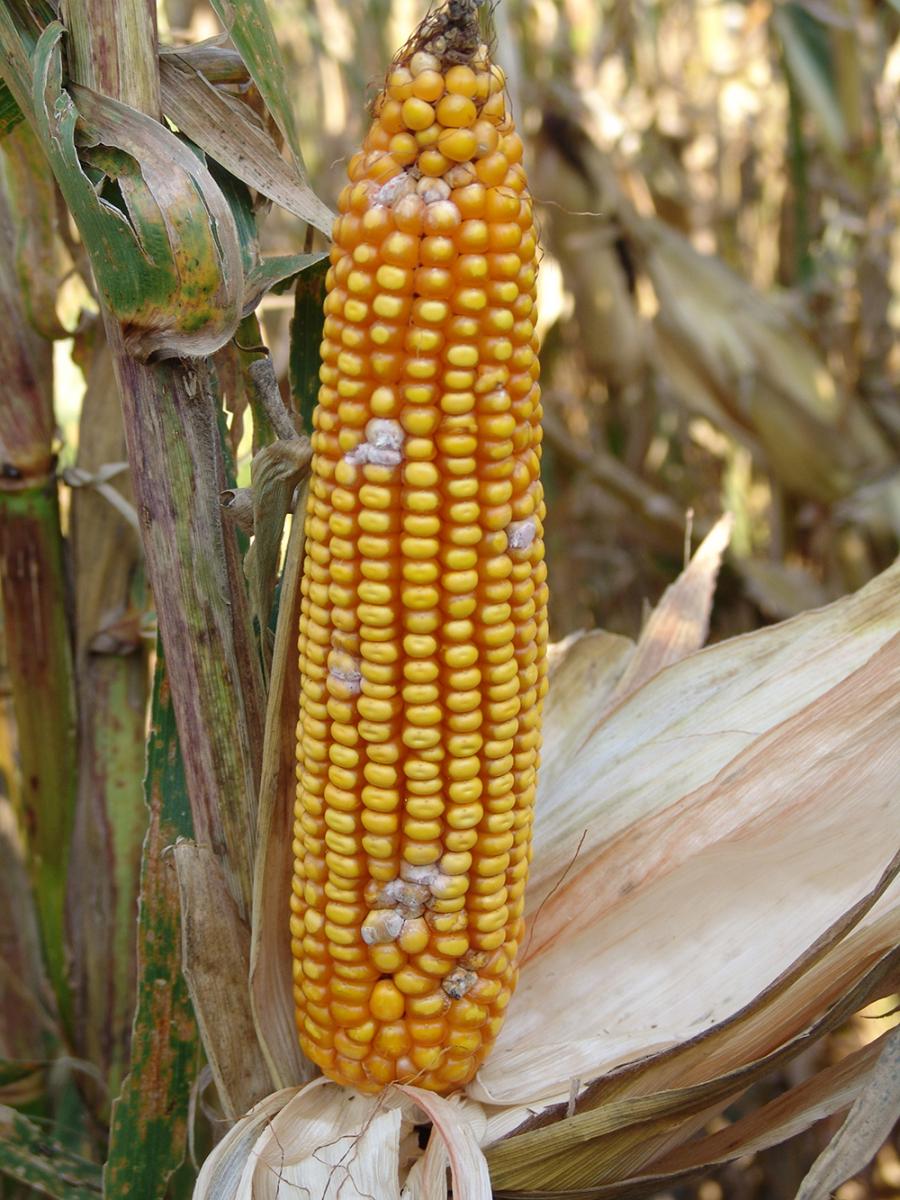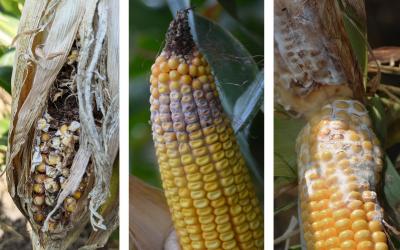Infected stalks often have shiny. Stalk rots are the most common diseases of dent corn in Illinois.
Bob Nielsen Purdue Agronomy Stalk rots of corn are a common problem in Indiana and appear each year with varying degrees of severity.

Stalk rots in corn. Fusarium stalk rot will cause the internal pith tissue to shred and may also cause a discoloration that as the pith tissue continues to rot becomes pinkish or salmon-colored. These sugars are used as energy for growth and tissue maintenance. Fusarium stalk rot Fusarium spp.
Stalk rots may cause lodging especially if the affected crop is not harvested promptly. He cuts off the stalk and splits the lower stem with a pocketknife looking especially closely at the nodes on the stalk. Charcoal rot begins as a root infection which spreads into the lower stalk internodes and causes early ripening shredding and breaking at the crown of the corn stalk.
They are caused primarily by plant pathogenic organisms such as fungi and bacteria but they can also result from abiotic stresses such as drought and flooding. Stalk rots leave stalks weak and unable to. Management of stalk rots of corn should include the following.
Stalk rots are likely to be an issue this growing season. Losses due to stalk rot vary from field to field and from one hybrid to another. In more advanced stages the disease can cause the development of black lesions visible on the outside of.
Depending on location stalk rot organisms may include anthracnose Gibberella Diplodia or Fusarium all of which survive in corn residue and are spread to the next crop by wind andor rain. Corn plants produce sugars carbon through photosynthesis. Fusarium stalk rot is caused by multiple fungal pathogens in the Fusarium genus.
Therefore rotation to crops other than corn for 1-2 years is very effective at reducing the inoculum in the field. Losses from stalk rots may occur directly when plants are prematurely killed and ears are lightweight and poorly finished or indirectly when harvest losses are increased due to lodging Fig. However Diplodia and Pythium have also been observed.
Choose corn products with greater levels of resistance to Diplodia stalk and ear rots and with good standability ratings. Fusarium stalk rot of corn. After pollination the ear becomes the major sink of sugars produced by the plant.
If the pith is discolored especially at the node its a sure sign of stalk rot he says. Corn ear rots can compromise corn grain quality and stalk rots lead to lodging of corn plants. Over the past week corn plants with accelerated senescence due to stalk rots are becoming visible.
The sclerotia germinates on the root surface and penetrates the host epidermal cells of the corn. Can cause stalk rots in corn. Stalk rots are one of the most frequent and damaging issues for corn production.
It is also the only corn stalk rot disease with a foliar phase. They reduce grain fill stalk integrity and accelerate senescence. Stalk rot can be detected by either pinching stalks or pushing on stalks.
Losses are due to 1 premature plant death which results in poor filling of ears or lightweight and poorly finished ears and 2 harvest. When significant leaf blight. It is important to scout corn fields for these two issues.
Corn plants produce sugars carbon through photosynthesis. Nanda notes that anthracnose stalk rot is the most common form in most cornfields in recent years. We have seen significant blighting of the leaves in the upper canopy predominantly from Gosss wilt northern corn leaf blight gray leaf spot and anthracnose top dieback.
Stalk rots cause damage and yield loss in many corn fields across North America each year. Lodged plants pose combining issues and downed plants which have ears touching the soil can lead to ear rots. If a stress event occurs plants will divert or remobilize sugars from the stalk.
Verticillioides the primary causal pathogen. Several different Fusarium spp. Although these fungi cause different symptoms their ultimate effect on the corn plant is the same.
Usually the culprit is stalk rot. Reduce Inoculum The fungus that causes Diplodia ear and stalk rots only infects corn and survives only on corn debris. Affected plants have shredded pith that may be a.
However it is not uncommon to walk corn fields where nearly every plant is upright yet nearly every plant is also showing stalk rot symptoms. It is among the most common stalk rots in the Midwest with F. Extra sugars are stored as free sugars and starch in the roots and stalk.
These diseases reduce annual yields by a minimum of 5 percent. Corn is infected during dry periods where the temperature hits 80-85 ºF 27-29 ºC. Corn and is one of the few stalk rot pathogens that frequently causes disease prior to senescence.
Losses in certain years reach 10 to 20 percent or more of the expected yield. Stalk rots occur to a greater or lesser degree every year in Indiana. Corn stalk rots are mainly caused by fungal pathogens though bacterial infections and insect injury can also lead to stalk rot development.
Stalk rots are one of the most frequent and damaging issues for corn production. The majority of stalk rot damage in Ontario is caused by three fungi Anthracnose Gibberella and Fusarium. Since 1970 anthracnose stalk rot has emerged as one of the two most important stalk rot diseases of corn in the country.
Anthracnose stalk rot is caused by the fungus Colletotrichum graminicola which also causes a leaf disease and is a common cause of top rot disease of corn. Several fungal pathogens cause stalk rots but this season the stalk rots being observed in corn fields are those. If more than 10-15 percent of the stalks are rotted the field should be harvested as soon as possible.
Development of stalk rot is. These sugars are used as energy for growth and tissue maintenance.

Raw Organic Yellow Seet Corn By Bhofack2 Raw Organic Yellow Seet Corn Ready To Cook Ad Yellow Seet Raw Organic Sweet Corn Vegetables Corn

Ear And Stalk Rot Diseases Becoming More Common In Corn Fields Cropwatch University Of Nebraska Lincoln

Landscaping And Hardscaping Growing Corn Growing Sweet Corn Harvest Corn

Scout For Ear And Stalk Rots In Corn Maryland Agronomy News

Scout Corn Fields For Stalk Rot Integrated Crop Management

